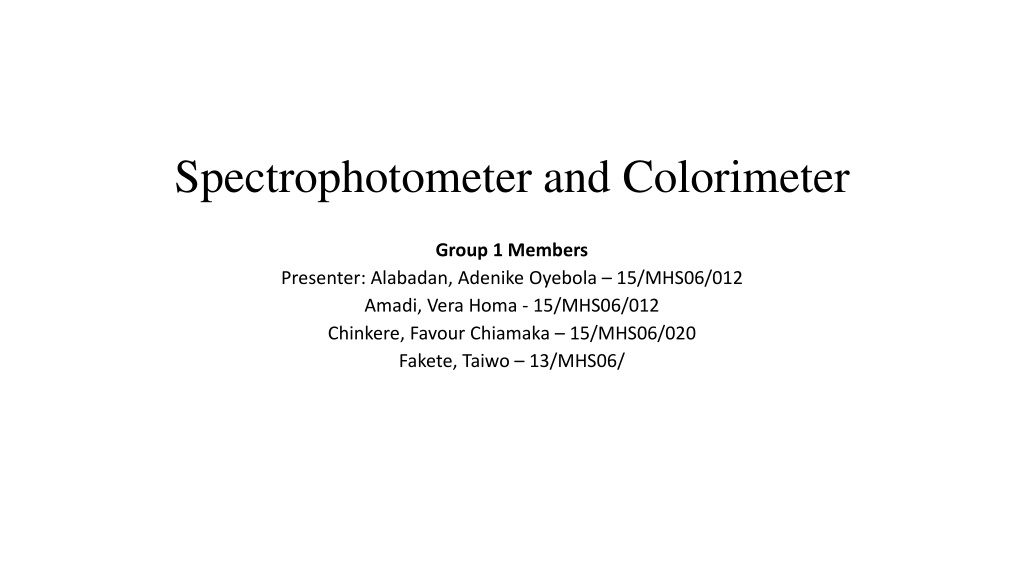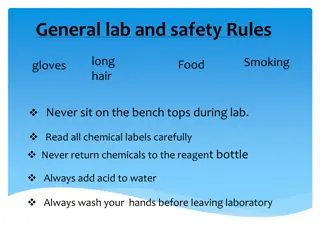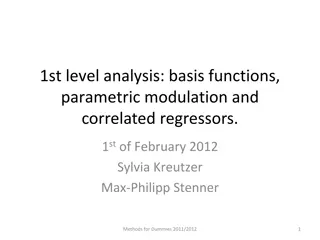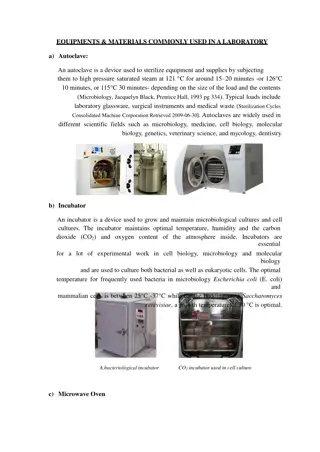Understanding the Functions and Principles of Spectrophotometry
Spectrophotometry is a vital technique in various scientific fields, allowing for the quantitative measurement of the reflection or transmission properties of materials based on principles like Lambert's Law and Beer's Law. This instrument, comprising a monochromator and a means of measuring light intensity, finds applications in microbiology, biochemistry, forensics, and medical health, among others. By analyzing colored compounds in the visible light range, spectrophotometers offer valuable insights in research and analysis.
Download Presentation

Please find below an Image/Link to download the presentation.
The content on the website is provided AS IS for your information and personal use only. It may not be sold, licensed, or shared on other websites without obtaining consent from the author. Download presentation by click this link. If you encounter any issues during the download, it is possible that the publisher has removed the file from their server.
E N D
Presentation Transcript
Spectrophotometer and Colorimeter Group 1 Members Presenter: Alabadan, Adenike Oyebola 15/MHS06/012 Amadi, Vera Homa - 15/MHS06/012 Chinkere, Favour Chiamaka 15/MHS06/020 Fakete, Taiwo 13/MHS06/
OUTLINE Introduction Mode of Operation/ Working principle Functions Types Parts Management Brands and Prices References
Spectrophotometer A Spectrophotometer is an instrument containing a monochromator, a device which produces a light beam containing wavelengths in a narrow band around a selected wavelength, and a means of measuring the ratio of that beam's intensity as it enters and leaves a cuvette99. This describes a single-beam photometer. Buie, 2011
Spectrophotometry in chemistry, is the quantitative measurement of the reflection or transmission properties of a material as a function of wavelength and a spectrometer is used for this measurement. It works based on two principles: Lambert s Law Beer s Law Alber et al., 2012
Principle Lambert s Law : The proportion of light absorbed by a medium is independent of the intensity of incident light. A sample which absorbs 75% (25% transmittance) of the light will always absorb 75% of the light, no matter the strength of the light source. Lambert s law is expressed as I/Io=T Where I = Intensity of transmitted light Io = Intensity of the incident light T = Transmittance This allows different spectrophotometers with different light sources to produce comparable absorption readings independent of the power of the light source. Bryan, 2010
Beers Law: The absorbance of light is directly proportional to both the concentration of the absorbing medium and the thickness of the medium. In Spectrophotometry the thickness of the medium is called the pathlength. In normal cuvette-based instruments the pathlength is 10 mm. Beer s law allows us to measure samples of differing pathlength, and compare the results directly with each other. Alber et al., 2012
Functions A spectrophotometer is used in many areas of science including microbiology, biochemistry, forensics, physics, and medical health. The spectrophotometer is used to measure colored compounds in the visible region of light (between 350 nm and 800 nm) thus it can be used to find more information about the substance being studied. Spectrophotometer can be used for a number of techniques such as determining optimal wavelength absorbance of samples, determining optimal pH for absorbance of samples, determining concentrations of unknown samples, and determining the pKa of various samples (Ninfa et al., 2010).
Functions Spectrophotometer is also a helpful process for protein purification and can also be used as a method to create optical assays of a compound. Additionally, Spectrophotometers are specialized to measure either UV or Visible light wavelength absorbance values. Because a spectrophotometer measures the wavelength of a compound through its color, a dye binding substance can be added so that it can undergo a color change and be measured. (Garrett and Grisham, 2013).
Types Single beam spectrophotometer: This uses a reference standard to standardize or blank the instrument before taking measurements. Single beam spectrophotometers are usually more compact and have a higher dynamic range. Double beam spectrophotometer: This splits the beam of light into two different paths, one of which passes through the sample while the other passes through a reference standard. Double beam spectrophotometers measure the ratio of light intensities and, therefore, are not as sensitive to fluctuations in the light source or detector. Other types of spectrophotometers include atomic absorption spectrophotometers and fluorescence spectrophotometers. Adeeyinwo et al., 2013
Parts There are five parts in a spectrophotometer: Light Sources:There are two light sources a tungsten lamp which generates visible light and a deuterium or hydrogen lamp which generates UV light. Deuterium lamp gives wider and more intense light in UV region than a hydrogen lamp. Monochromators: To select the particular wavelength filter or monochromators are used to split the light from the light source. Cuvettes: Cuvettes are optically transparent cells made of glass / silica / plastic. Test tube or Cuvettes are used to hold the color solutions. Photocell or photomultiplier tube: is a photoelectric device which converts light energy into electrical energy. when light falls on the detector system, an electric current is generated, this reflects the Galvanometer reading. Recorder: The current from the detector is fed to the measuring device, the Galvanometer, shows the meter reading that is directly proportional to the intensity of light. Merrifield, 2014
Colorimeter Acolorimeter is a device used in colorimetry that measures the absorbance of particular wavelengths of light by a specific solution. It is commonly used to determine the concentration of a known solute in a given solution. Colorimetry is a technique "used to determine the concentration of coloured compounds in solution. A colorimeter is a device used to test the concentration of a solution by measuring its absorbance of a specific wavelength of light (not to be confused with the tristimulus colorimeter used to measure colours in general). Timma et al., 2015
Principle A colorimeter is based on the photometric technique which states that when a beam of incident light of intensity I0passes through a solution, a part of the incident light is reflected (Ir), a part is absorbed (Ia) and rest of the light is transmitted (It) Thus, I0= Ir+ Ia+ It Beer s Law This law states that the amount of light absorbed is directly proportional to the concentration of the solute in the solution. Log10I0/It= asc where, as= Absorbency index c = Concentration of Solution
Principle Lambert s Law The Lambert s law states that the amount of light absorbed is directly proportional to the length and thickness of the solution under analysis. A = log10I0/It= asb Where, A = Absorbance of test as= Absorbance of standard b = length / thickness of the solution Robert, 2008
Functions Colorimeters are used for a wide range of application across the chemical and biological field including but not limited to the analysis of Blood, Determining the rates of reaction, Laboratory quality control. The colorimeter is commonly used for the determination of the concentration of a colored compound by measuring the optical density or its absorbance. It can also be used for the determination of the course of the reaction by measuring the rate of formation and disappearance of the light-absorbing compound in the range of the visible spectrum of light. By colorimeter, a compound can be identified by determining the absorption spectrum in the visible region of the light spectrum. (Blues et al., 2004)
Types There are many different types of colorimeters, they include The colour densitometer: This measures the density of primary colours. The colour photometer: This measures the reflection and transmission of colour. Digital, also called laboratory, and portable: Digital versions are most often used in a lab setting for sampling or in the classroom for educational purposes. Portable versions can be carried anywhere, regardless of environmental conditions, to test things like water and soil samples on site. Shivok et al., 2014
Parts There are 5 essential parts in a colorimeter: Light Source The most common source of light used in colorimeter is a tungsten filament. Monochromator To select the particular wavelength filter or monochromators are used to split the light from the light source. Sample holder Test tube or Cuvettes are used to hold the color solutions they are made up of Glass at the visible wavelength. Photo Detector System when light falls on the detector system, an electric current is generated, this reflects the Galvanometer reading. Measuring device The current from the detector is fed to the measuring device, the Galvanometer, shows the meter reading that is directly proportional to the intensity of light. (Johns and Warren, 2001)
Maintenance Any spill on, or around the instrument should be cleaned immediately. At the end of the day, turn off the instrument or disconnect the power source or the battery terminals as appropriate. Keep the cuvette chamber empty and closed when not in use. Cover the instrument after use. Store appropriately, protected from dust. Replace blown fuses and bulbs according to the manufacturer s instructions. If the equipment is faulty, consult a qualified biomedical engineer. Verify that the instrument is away from equipment generating vibrations and direct solar radiation. Check that there is no excessive humidity, dust or high temperature. Ensure that there is no source of smoke, gas or corrosive emissions nearby. (Aston, 2009)
References Blues, J., Bayliss, D. and Buckley, M.(2004) The calibration and use ofpiston pipettes, National Physical Laboratory, Teddigton, Johns and Warren L. (2001) Selection of basic laboratory equipment for laboratories with limited resources, World Health Organization. Aston, R. (2009) Principles of Biomedical Instrumentation and Measurement, Merrill Publishing Company. Ninfa AJ, Ballou DP, Benore M (2010). Fundamental Laboratory Approaches for Biochemistry and Biotechnology (2nd ed.). Hoboken: Wiley & Sons. ISBN 9780470087664. OCLC 488246403 Trumbo, Toni A.; Schultz, Emeric; Borland, Michael G.; Pugh, Michael Eugene (April 27, 2013). "Applied Spectrophotometry: Analysis of a Biochemical Mixture". Biochemistry and Molecular Biology Education. 41 (4): 242 50. doi:10.1002/bmb.20694. PMID 23625877 Middlesex, UK,
Mettler-Toledo AG, Analytical. 2016. Retrieved Dec 23, 2018. Cortez, C.; Szepaniuk, A.; Gomes da Silva, L. (May 1, 2010). "Exploring Proteins Purification Techniques Animations as Tools for the Biochemistry Teaching". Journal of Biochemistry Education. 8 (2): 12. doi:10.16923/reb.v8i2.215. Garrett RH, Grisham CM (2013). Biochemistry. Belmont, CA: Cengage. p. 106. ISBN 978-1133106296. OCLC 801650341. Ensor Roslyn (May 27, 1936). "Spectrophotometry of proteins Biochemical Journal. 30 (10): 1795 1803. doi:10.1042/bj0301795. PMC 1263262. PMID 16746224.























